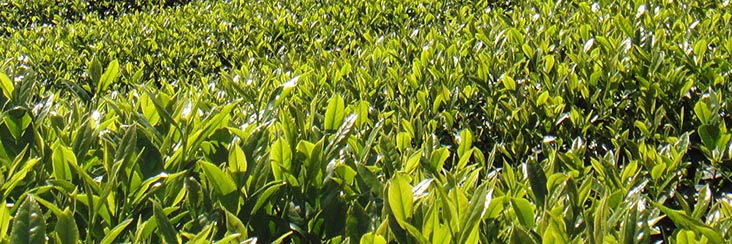
Eco-Cha's Top 5 Teas of 2014
A great year for tea, 2014 was filled with fantastic oolong and inspiring tea farmers. From the smooth and floral tea grown on Li Shan Mountain to rich and roasted Traditional Dong Ding Oolong from Phoenix Valley - here are our favorite, responsibly produced oolong teas from 2014.

1. Four Seasons Spring Oolong Tea
Late Winter 2014. Herbal, floral, savory. Song Bo Lin, Nantou, Taiwan.
By harvesting only three times a year, by hand, and using all-natural fertilizers (in contrast to other farms in this region that machine harvest 6 times a year) this farmer is allowing his plants to produce the best quality tea leaves possible. He is a model of sustainable agricultural practice in the tea industry and his tea is the highest quality that we have encountered from this region.
This tea produces a substantial, balanced brew that is a prime example of the importance of farm management and skillful processing. This late winter harvest is the best batch we’ve tasted from this farm so far, in fact we think it could be the best batch of Four Seasons Spring Oolong Tea that we’ve ever had.

2. Organic Dong Ding Oolong Tea - Mr. Lin’s Inaugural Harvest
Winter 2014. Heavy roast: Woodsy, nutty, honey. Light roast: Toasted grains, fresh bread, floral. Shanzhuhu, Lugu, Taiwan.
Our partnership with organic oolong farmer Mr. Lin has been the most meaningful and progressive aspect of our work in the Taiwanese tea industry this year. Our Indiegogo campaign ‘Promote Sustainability - Get Great Tea’ was the story of his transition from large-scale to small-scale farming and campaign backers shared in the very first harvest after his farm and home-factory were certified organic.
This tea has a balanced, mild, yet substantial quality that is soothing and invigorating. It has lots of brewing power too! Our first time brewing the heavily roasted version of this tea, we brewed it ten times and it still maintained its flavor and composition!

3. Dong Ding Oolong Tea
Fall 2014. Nutty/sweet, cashews, dried fruit. Yong Long, Nantou, Taiwan.
The tea was grown on a small plot of land that yielded less than 50 kg of tea leaves. It was cured using traditional methods by a professional tea judge who learned the trade from his award-winning tea making father.
This harvest of Dong Ding Oolong has a unique character that we find quite special. It is substantial and rich, with a sweetness like raw sugar cane, pecans, and cashews. The artisan who made it attributes this quality to an extra dose of all-natural soybean mash fertilizer. The fall growing conditions combined with repeated long, slow, low-temperature roastings make this tea a fine example of an artisan oolong.

4. Organic High Mountain Oolong Tea
Spring 2014. Asian pear, honey, cashews. He Huan Shan, Taiwan.
The environment and management of this tea garden the most ideal we’ve ever seen. This farm is a prototype of natural tea cultivation in Taiwan. The growing conditions in spring 2014 combined with the farmer’s expert processing produced the best batch of tea we’ve ever procured from this farm.
This batch was made extra special due to the fact that the leaves were affected by the Green Leaf Hopper – a tiny insect that feeds on the new leaves causing changes in the flavor of the tea. The honey-like character of “bug-bitten tea” (or Concubine Oolong) is typically more pronounced if the leaves are roasted so we had this batch custom-roasted. It tastes of autumn leaves, fresh-cut fruitwood, and honey with a clean, lingering aftertaste.

5. Li Shan High Mountain Oolong Tea
Spring 2014. Floral, rainforest, woody. Winter 2014. Tsui Hua Village, Lishan, Taichung, Taiwan.
This is a small, family-run tea farm in Taiwan’s highest elevation tea growing region. Most of this batch was only lightly-oxidized, as is standard for High Mountain Oolong Tea. We were lucky procure a small amount (the farmer’s reserve) of a single day’s harvest that was custom ordered to be oxidized more than usual. This batch was made for a private client looking for a well-oxidized Li Shan Oolong Tea. He reserves an entire day's harvest to be processed just the way he likes it.
More oxidation results in a more substantial, balanced brew. The aroma, flavor, and some of the 'fresh spring fragrance' become more subtle, but the tea develops a richer and smoother texture and composition. This is a family with a rich tea-making history and we were grateful to be able to share this special batch of tea with you.
We hope you enjoyed this list. Which were your favorite teas of 2014? Let us know in the comments below or on our Facebook page.

